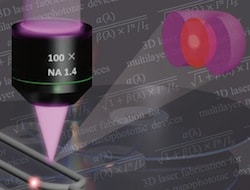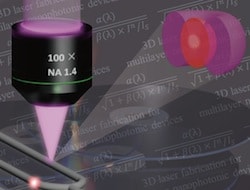
Foresight’s interest is in advancing nanotechnology to the point of developing high-throughput atomically precise manufacturing, but it is worth noting occasionally the potential applications of nanoscale technologies that achieve less than atomic precision. These two examples point toward several-orders-of-magnitude improvement in data storage technology. A hat tip to Phys.org for reprinting this article written by researchers at Australia’s Swinburne University of Technology “More data storage? Here’s how to fit 1,000 terabytes on a DVD” by M Gu, Y Cao, and Z Gan:
In Nature Communications [open access article] today, we, along with Richard Evans from CSIRO, show how we developed a new technique to enable the data capacity of a single DVD to increase from 4.7 gigabytes up to one petabyte (1,000 terabytes). This is equivalent of 10.6 years of compressed high-definition video or 50,000 full high-definition movies. …
The article describes how they succeeded in greatly increasing the storage capacity of optical disks by burning spots smaller than the half-wavelength limit (about 500 nm) specified by Abbe’s limit. They used a two-light-beam method in which the first beam activates the writing and the second beam, of a different color, is donut-shaped and overlaps the first beam, inhibiting its function where they overlap. The canceling effect of the second beam confines the writing to the center of the writing beam, producing an effective focal spot of only 9 nm, with 52 nm two-line resolution. The authors point out that they have achieved comparable resolution to electron beam lithography, but that, unlike electron beam lithography, their three-dimensional optical beam lithography permits arbitrary three-dimensional nanofabrication, which greatly increases the number of dots that can be written to one optical device.

A second approach uses a laser to write on three layers of self-assembled nanostructures created in fused quartz. In this case the resolution is much coarser than in the above case—dots separated by 5 microns (5000 nm)—but each dot is characterized by five parameters: three spatial coordinates and two birefrigence parameters. “5D nanostructured quartz glass optical memory could provide ‘unlimited’ data storage for a million years“:
University of Southampton and Eindhoven University of Technology scientists have developed a new technology that could store vast quantities of information — 360 TB on a disc, about 100 times more than current disk drives — for more than a million years …
Using a high speed femtosecond laser, data is written on self-assembled nanostructures created in fused quartz, and stored in five dimensions: size and orientation in addition to the three-dimensional position on the nanostructured material.
Each disc has three layers … of nanostructured dots, with dots separated by five microns (one millionth of a meter) …. The self-assembled nanostructures change the way light travels through glass, modifying polarization of light that can then be read by combination of optical microscope and a polarizer, similar to that found in Polaroid sunglasses. …
The disc has thermal stability up to 1000°C (1832°F) and practically unlimited lifetime. …
The lead researcher further notes that the final disc will have 400 layers, look like a normal CD made of glass, and will be read by a laser scanning device similar to the one used to read CD, DVD and Blu-ray discs. As someone who looks forward to advanced technology making a long future possible, I find it comforting to think that even near-term nanotechnology will make possible 300 TB disks that last a million years.
—James Lewis, PhD
